





Click to enlarge
BZO09.jpg (taken 24.10.2013)
placename:- Plains of Basingthwaite
 goto source
goto sourceGentleman's Magazine 1751 p.52 "[from Skiddaw] ... in the prospect round, nature has lavished such variety of beauty as can scarce be believed upon report, or imagined by the most luxuriant fancy. The plains of Basingthwaite, watered by a fine lake, appear like a paradise to the West; ..."
placename:- Vale of Keswick
placename:- Vale of Derwent Water
placename:- Devil's Chamberpot
 goto source
goto sourceAddendum; Dr Brown's Letter Describing the Vale and Lake of Keswick
Page 193:- "IN my way to the north, from Hagley, I passed through Dovedale; and, to say the truth, was disappointed in it.- When I came to Buxton, I visited another or two of their romantic scenes; but these are inferior to Dovedale. They are but poor miniatures of Keswick; which exceeds them more in grandeur than I can give you to imagine; and more, if possible, in beauty than in grandeur."
"Instead of the narrowing strip of valley which is seen at Dovedale, you have at Keswick a vast amphitheatre, in circumfe-"
 goto source
goto sourcePage 194:- "[circumfe]rence above twenty miles. Instead of a meagre rivulet, a noble living lake, ten miles round, of an oblong form, adorned with a variety of wooded islands. The rocks, indeed, of Dovedale are finely wild, pointed, and irregular; but the hills are both little and unanimated; and the margin of the brook is poorly edged with weeds, morass, and brushwood. But at Keswick, you will on one side of the lake, see a rich and beautiful landscape of cultivated fields, rising to the eye, in fine inequalities, with noble groves of oak, happily dispersed, and climbing the adjacent hills, shade above shade, in the most various and picturesque forms. On the opposite shore you will find rocks and cliffs of stupendous height, hanging broken over the lake in horrible grandeur, some of them a thousand feet high, the woods climbing up their steep and shaggy sides, where mortal foot never yet approached. On these dreadful heights, the eagles build their nest; a variety of water-falls are seen pouring from their summits, and tumbling in vast sheets from rock to rock, in rude and terrible magnificence; while on all sides of this immense amphitheatre, the lofty mountains rise around, piercing the clouds, in shapes as spiry and fantastic as the very rocks of Dovedale - To this I must add the frequent and bold projection of the cliffs into the lake, forming noble bays and promontories: in other parts they finely retire from it, and often open in abrupt chasms or cliffs, through which at hand you see rich and cultivated vales, and beyond these, at various distances, mountain rising over mountain, among which, new prospects present themselves in mist, till the eye is lost in agreeable perplexity:-"
"Where active fancy travels beyond sense, / And pictures things unseen ---"
"Were I to analyse the two places into their constituent principles, I should tell you, that the full perfection of Keswick consists of three circumstances, beauty, horror, and immensity united; the second of which is alone found in Dovedale. Of"
 goto source
goto sourcePage 195:- "beauty it hath little: nature having left it almost a desart: neither its small extent. nor the diminutive and lifeless form of the hills, admit magnificence - But to give you a complete idea of these three perfections, as they are joined in Keswick, would require the united powers of Claude, Salvator, and Poussin. The first should throw his delicate sunshine over the cultivated vales, the scattered cots, the groves, the lake, and wooded islands. The second should dash out the horror of the rugged cliffs, the steeps, the hanging woods, and foaming waterfalls; while the grand pencil of Poussin should crown the whole with the majesty of the impending mountains."
"So much for what I would call the permanent beauties of this astonishing scene. Were I not afraid of being tiresome, I could now dwell as long on its varying or accidental beauties, I would sail round the lake, anchor in every bay, and land you on every promontory and island. I would point out the perpetual change of prospects; the woods, rocks, cliffs, and mountains, by turns vanishing or rising into view: now gaining on the sight, hanging over our heads in their full dimensions, beautifully dreadful; and now by change of situation, assuming new romantic shapes, retiring and lessening on the eye, and insensibly losing themselves in an azure mist. I would remark the contrast of light and shade, produced by the morning and evening sun; the one gilding the western, and the other the eastern side of this immense amphitheatre; while the vast shadow projected by the mountains, buries the opposite part in deep and purple gloom, which the eye can hardly penetrate: the natural variety of colouring which the several objects produce, is no less wonderful and pleasing; the ruling tints in the valley being those of azure, green, and gold, yet ever various, arising from an intermixture of the lake, the woods, the grass, and corn-fields; these are finely contrasted by the grey rocks and cliffs; and the whole heightened by the yellow streams of light, the purple hues, and misty azure of the mountains. Sometimes a serene air and clear sky disclose the tops of the highest hills; at others you see the clouds in-"
 goto source
goto sourcePage 196:- "[in]volving their summits, resting on their sides, or descending to their base, and rolling among the vallies, as in a vast furnace.- When the winds are high, they roar among the cliffs and caverns, like a peal of thunder; then too the clouds are seen in vast bodies, sweeping along the hills in gloomy greatness, while the lake joins the tumult and tosses like a sea. But in calm weather, the whole scene becomes new; the lake is a perfect mirror; and the landscape in all its beauty, islands, fields, woods, rocks, and mountains, is seen inverted and floating on its surface.- I will now carry you to the top of a cliff, where if you dare approach the ridge, a new scene of astonishment presents itself, where the valley, lake, and islands seem lying at your feet, where this expanse of water appears diminished to a little pool, amidst the vast immeasurable objects that surround it: for here the summits of more distant hills appear beyond those you had already seen; and rising behind each other in successive ranges, and azure groups of craggy and broken steeps, form an immense and awful picture, which can only be expressed by the image of a tempestuous sea of mountains.- Let me now conduct you down again, to the valley, and conclude with one circumstance more, which is, that a walk by still moonlight (at which time the distant water-falls are heard in all their variety of sound) among these enchanting dales, opens a scene of such delicate beauty, repose, and solemnity, as exceeds all description."
 goto source
goto sourceAddendum; From Dr. Dalton's descriptive poem enumerating the Beauties of the Vale of Keswick, about 1775
Page 197:- "... ... TO NATURE'S pride, / Sweet Keswick's vale, the muse will guide: / The muse who trod th'enchanted ground, / Who sail'd the wond'rous lake around, / With you will haste once more to hail / The beauteous brook of Borrowdale."
"From savage parent, gentle stream! / Be thou the muse's favourite theme:- / O soft insinuating glide / Silent along the meadow's side, / Smooth o'er the sandy bottom pass, / Resplendent all through fluid glass, / Unless upon thy yielding breast / Their painted heads the lilies rest, / To where in deep capacious bed, / The liquid lake is widely spread."
"Let other streams rejoice to roar / Down the rough rocks of dread Lowdore, / Rush raving on with bois'trous sweep, / And foaming rend the 'frighted deep, / Thy gentle genius shrinks away / From such a rude unequal fray; / Through thine own native dale, where rise / Tremendous rocks amid the skies, / Thy waves with patience slowly wind, /"
 goto source
goto sourcePage 198:- "Till they the smoothest channel find, / Soften the horrors of the scene, / And through confusion flow serene."
"Horrors like these at first alarm, / But soon with savage grandeur charm, / And raise to noblest thoughts the mind; / Thus by thy fall, Lowdore, reclin'd, / The craggy cliff, impendant wood, / Whose shadows mix o'er half the flood, / The gloomy clouds with solemn sail, / Scarce lifted by the languid gale, / O'er the capp'd hill, and dark'ned vale:- / The rav'ning kite, and bird of Jove, / Which round the aerial ocean rove, / And, floating on the billowy sky, / With full expanded pinions fly, / Then flutt'ring on their bleating prey, / Thence with death-dooming eye survey:- / Channels by rocky torrents torn, / Rocks to the lake in thunders borne, / Or such as o'er our heads appear / Suspended in their midst career, / To start again at his command, / Who rules fire, water, air, and land, / I view with wonder and delight, / A pleasing, though an awful sight: / For, seen with them, the verdant isles / Soften with more delicious smiles, / More tempting twine their op'ning bowers, / More lovely grow the purple flowers, / More smoothly slopes the border gay, / In fairer circles bends the bay, / And last, to fix our wand'ring eyes, / Thy roofs, O Keswick, brighter rise, / The lake, and lofty hills between, / Where giant Skiddaw shuts the scene."
 goto source
goto sourceAddendum; Mr Gray's Journal, 1769
Page 202:- "..."
"Oct. 2. I set out at ten for Keswick [from Penrith], ... saw from an eminence at two miles distance, the vale of Elysium in all its verdure; the sun then playing on the bosom of the lake, and lighting up all the mountains with its lustre. ..."
 goto source
goto sourcePage 208:- "Oct. 6. ... The inhabitants here [Ouse Bridge], on the contrary, call the vale of Derwent-water, the Devil's chamberpot,"
 goto source
goto sourcePage 209:- "..."
"Botany might be studied here to great advantage at another season, because of the great variety of soils and elevations, all lying within a small compass. I observed nothing but several lichens, and plenty of gale, or Dutch myrtle, perfuming the borders of the lake. ... ... They sow chiefly oats and bigg here, which are now cutting and still on the ground; the rains have done much hurt; yet observe, the soil is so thin and light, that no day has passed in which I could not walk out with ease; and you know I am no lover of dirt. Fell mutton is now in sea-"
 goto source
goto sourcePage 210:- "[sea]son for about six weeks; it grows fat on the mountains, and nearly resembles venison. Excellent pike, and perch, here called bass; trout is now out of season; partridge in great plenty."
 goto source
goto sourceMrs Radcliffe's Ride over Skiddaw, 1794
Page 304:- "... A narrow path now wound along steep green precipices, the beauty of which prevented the danger there was from being perceived. Derwent-water was concealed by others that rose above them; but that part of the vale of Keswick which separates the two lakes, and spreads a rich level of three miles, was immediately below; Crosthwaite church nearly in the centre, with the vicarage rising among trees. More under shelter of Skiddaw, where the vale spreads into a sweet retired nook, lay the house and grounds of Dr. Brownrigg ..."
 goto source
goto source click to enlarge
click to enlargeGLP316.jpg
plate opposite vol.2 p.41 in Observations on Picturesque Beauty published by T Cadell and W Davies, Strand, London, 1808.
caption from the list of plates:- "XVI. AN illustration of that beautiful species of landscape, produced by an extensive vale. Gradation is among the first principles of picturesque beauty. A graduating light, a graduating shade, or a graduating distance, are all beautiful. When the vale therefore does not exceed such a proportion, as is adapted to the eye, it is pleasing to see it fading away gradually, from the foreground, into the obscurity of distance. It presents indeed only one uniform idea; which, tho often grand, is not generally so pleasing, as the variety, and intricacy of a country broken into parts, and yet harmoniously combined."
This may be a representation of the Vale of Keswick?
item:- Armitt Library : A918.16
Image © see bottom of page
 goto source
goto sourcevol.2 p.40 "... As we rode nearer the northern limit of this chain, Skiddaw, which is by much the highest mountain, appeared in perspective, the least. Behind these mountains arise, in order, Mosedale-fell - Carric - and Caudbeck - the tops of which we sometimes saw, from the higher grounds, peering, in their blue attire, over the concave parts of the browner mountains, which stood nearer the eye."
"Between us, and this circular chain, which occupied the whole horizon on the left, was spread a very extensive vale; stretching from side to side hardly less the seven or eight miles; and in length winding out of sight. It affords little beauty, except what arises from the gradations of distance: but it suggests an idea of greatness; which space, and grand boundaries, however unadorned, will always suggest."
"This idea hath sometimes misled the tasteless improver of little scenes. He has heard, the space gives beauty; but not knowing how to accommodate the rule to circumstances, he"
 goto source
goto sourcevol.2 p.41 "often shews all that is to be seen; when, in fact, he should have hid half of it, as a deformity. Mere space gives the idea of grandeur, rather than of beauty. Such an idea the ocean presents. Grandeur therefore is not attained by attempting it; while beauty is often lost. ..."
placename:- Elysium of the North
 goto source
goto sourcePage 182:- "..."
"[at Keswick] ... Its vale a circle between land and water of about 20 miles is the Elysium of the north. The form of the lake is irregular, extending about three miles and an half from north to south and about one mile and an half broad; ... the river Derwent passes through and gives name to it. The southern extremity is a composition of all that is horrible. An immense chasm opens up in the midst, whose entrance is divided by a rude conic hill, once topt by a castle, beyond a chain of craggs, patched with snow, and containing various minerals, overshading the dark winding deeps of Borrowdale. The north view is a beautiful contrast."
"Skiddaw shews its vast base, and bounding all that part of the vale rises gently 1100 yards perpendicular from the broadwater with two heads, with a smooth verdant front, on whose top is Skiddaw maen, ... Each boundary of the lake partakes of the extremities. The southern varies in rocks of different forms from the tremendous precipices of the Lady's leap and broken front of the Falcon's nest, and the more distant concave curve of Lowdore, a length of precipices intermixed with trees and cataracts. On the north side is a salt spring, once belonging to the monks of Furness, sheep-pastures on the sides of the lofty hills, and woods running down to the water's edge: But most of the antient woods have been cut down by the commissioners for Greenwich hospital. The three islands on this circular lake are finely disposed. ..."
placename:- Vale of Keswick
 goto source
goto sourcepage xiv "..."
"THE VALE OF KESWICK."
"This Vale stretches, without winding, nearly North and South, from the head of Derwent Water to the foot of Bassenthwaite Lake. It communicates with Borrowdale on the South; with the river Greta, and Thirlmere, on the East, with which the Traveller has become acquainted on his way from Ambleside; and with the Vale of Newlands on the West - which last Vale he may pass through, in going to, or returning from, Buttermere. ..."
"..."
 goto source
goto sourcepage 35 "... I will conclude this section with a night-scene suggested by the Vale of Keswick. The Fragment is well known; but it gratifies me to insert it, as the Writer was one of the first who led the way to a worthy admiration of this country."
""Now sunk the sun, now twilight sunk, and night
Rode in her zenith; not a passing breeze
Sigh'd to the grove, which in the midnight air
Stood motionless, and in the peaceful floods
Inverted hung: for now the billows slept
Along the shore, nor heav'd the deep; but spread"
 goto source
goto sourcepage 36 "A shining mirror to the moon's pale orb,
Which, dim and waning, o'er the shadowy cliffs,
The solemn woods, and spiry mountain tops,
Her glimmering faintness threw: now every eye,
Oppress'd with toil, was drown'd in deep repose,
Save that the unseen Shepherd in his watch,
Propp'd his crook, stood listening by the fold,
And gaz'd the starry vault, and pendant moon;
Nor voice, nor sound, broke on the deep serene;
But the soft murmur of soft-gushing rills,
Forth issuing from the mountain's distant steep,
(Unheard till now, and now scarce heard) proclaim'd
All things at rest, and imag'd the still voice
Of quiet, whispering in the ear of night.""
placename:- Vale of Keswick
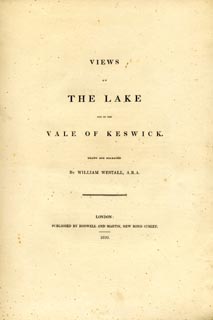 click to enlarge
click to enlargeWTL1T.jpg
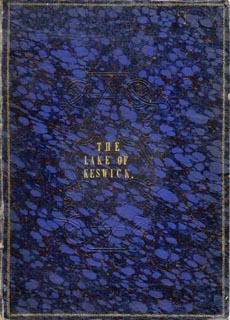 click to enlarge
click to enlargeWTL1C.jpg
embossed, cover "THE / LAKE OF / KESWICK"
printed, tile page "VIEWS / OF / THE LAKE / AND OF THE / VALE OF KESWICK. / DRAWN AND ENGRAVED / BY WILLIAM WESTALL, A.R.A. // LONDON: / PUBLISHED BY RODWELL AND MARTIN, NEW BOND STREET. / 1820."
item:- Armitt Library : A6671
Image © see bottom of page
placename:- Vale of Keswick
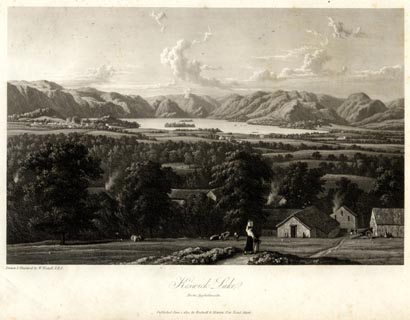 click to enlarge
click to enlargeWTL101.jpg
printed, bottom left, centre "Drawn & Engraved by W. Westall A.R.A. / Keswick Lake. / From Applethwaite. / Published June 1, 1820, by Rodwell &Martin, New Bond Street."
item:- Armitt Library : A6671.1
Image © see bottom of page
placename:- Vale of Keswick
 click to enlarge
click to enlargeWTL312.jpg
"Swinside. Grisedale Pike. 2680 feet. Keswick Lake. Whinlatter. Kings Seat. The Barfe. Bassenthwaite Lake. Greata Hall. Mr. Southey's. Wilhop brows. Skiddaw Dod. Applethwaite. Carlside. Summit of Skiddaw. 3022ft. / Drawn & Engraved by W. Westall A.R.A. / The Vale of Keswick, from the Ambleside road. / Published by Ackermann and Co, 96 Strand. 1836."
item:- Armitt Library : A6658.12
Image © see bottom of page
placename:- Vale of Keswick
 goto source
goto source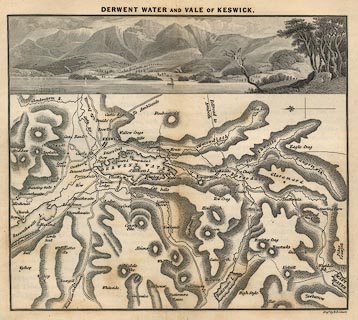 click to enlarge
click to enlargeFD04.jpg
Map and print, uncoloured engraving, Derwent Water and Vale of Keswick, engraved by W H Lizars, published by Charles Thurnham, Carlisle, and by R Groombridge, 5 Paternoster Row, London, 1843. "DERWENT WATER AND VALE OF KESWICK."
item:- JandMN : 100.3
Image © see bottom of page
placename:- Vale of Keswick
 click to enlarge
click to enlargeFD04.jpg
"DERWENT WATER AND VALE OF KESWICK"
item:- JandMN : 100.3
Image © see bottom of page
item:- storm; rain; wind; thunder; lightning; hail
 goto source
goto sourcePage 10:- "..."
"Heavy rain sometimes falls in the valley, when it is quite fair, and the sky clear, on the tops of mountains. On the 5th of July (the hottest day of last summer), this county was visited by a dreadful storm of Thunder, Lightning, Hail, and Rain, which continued from two to half-past four o'clock, in the afternoon."
"Two gentlemen, who were on the top of Skiddaw during"
Miller 1847
 goto source
goto sourcePage 11:- "this storm, state, that whilst the rain was pouring down in torrents in the valley, not a drop fell on the summit of the mountain. In this elevated position, the sky was clear, and the atmosphere calm and untroubled, when, below them, the elemental war was raging with the most terrific fury. The spectators describe the scene as being awfully grand, beyond conception."
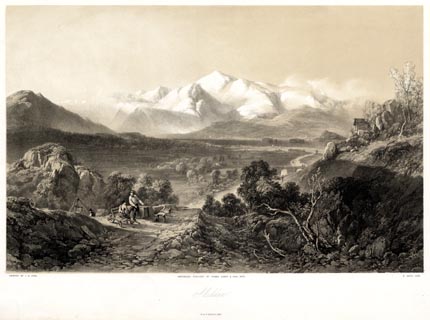 click to enlarge
click to enlargePYN206.jpg
"PAINTED BY J. B. PYNE. / W. GAUCI LITH. / MANCHESTER, PUBLISHED BY THOMAS AGNEW & SONS, 1853. / Skiddaw / M & N HANHART IMPT."
From the descriptive text:- "... The intellectual tourist may study some of the general laws which govern the universe during an ascent of this mountain. A thermometer will exhibit a difference of temperature betwixt the plain and summit of some nine or ten degrees Fahrenheit; and the mercury in a barometer will descend rather more than three inches: that is to say, one-tenth of the whole atmosphere will have been passed through. ... "
item:- Armitt Library : A6678.7
Image © see bottom of page
placename:- Vale of Keswick
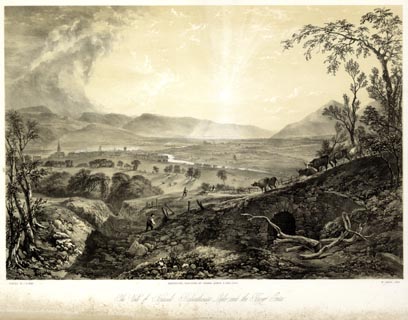 click to enlarge
click to enlargePYN208.jpg
"PAINTED BY J. B. PYNE. / W. GAUCI LITH. / MANCHESTER, PUBLISHED BY THOMAS AGNEW & SONS, 1853. / The Vale of Keswick, Bassenthwaite Lake, and the River Greta. / M & N HANHART IMPT."
item:- Armitt Library : A6678.9
Image © see bottom of page
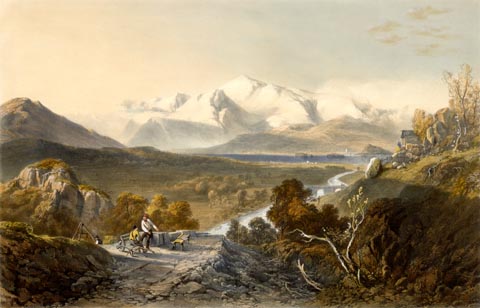 click to enlarge
click to enlargePYN406.jpg
item:- Armitt Library : A6677.7
Image © see bottom of page
placename:- Vale of Keswick
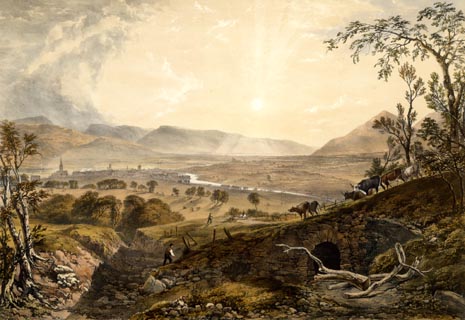 click to enlarge
click to enlargePYN408.jpg
item:- Armitt Library : A6677.9
Image © see bottom of page
 goto source
goto source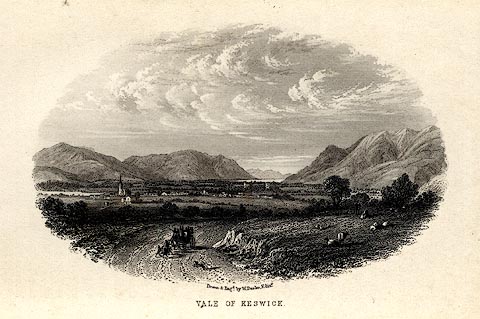 click to enlarge
click to enlargeMNU111.jpg
Print, engraving, Vale of Keswick, drawn and engraved by W Banks, Edinburgh, published by John Garnett, Windermere, Westmorland, and by Whittaker and Co, London, 1855. "Drawn &Eng'd by W Banks Sc Edinr. / VALE OF KESWICK."
item:- Armitt Library : A1159.11
Image © see bottom of page
placename:- Vale of Keswick
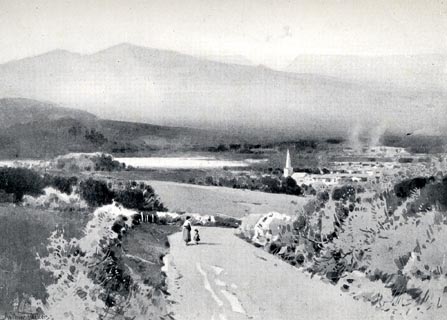 click to enlarge
click to enlargeRSN113.jpg
Tipped in opposite p.50 of Wordsworthshire by Eric Robertson.
printed at bottom:- "THE VALE OF KESWICK"
signed at painting lower left:- "Arthur Tucker"
item:- JandMN : 197.13
Image © see bottom of page
placename:- Vale of Keswick
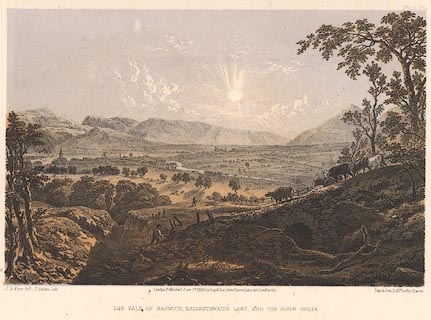 click to enlarge
click to enlargePY24.jpg
"Vale of Keswick, Bassenthwaite Lake and the River Greta"
item:- JandMN : 97.21
Image © see bottom of page
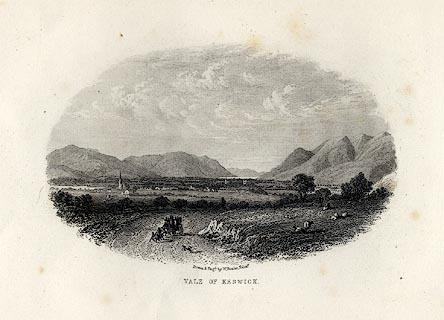 click to enlarge
click to enlargeGAR708.jpg
Included in Views of the English Lakes.
printed at bottom:- "Drawn &Engd. by W. Banks, Edinr. / VALE OF KESWICK."
item:- JandMN : 165.8
Image © see bottom of page
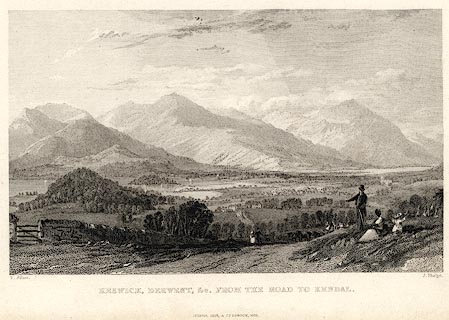 click to enlarge
click to enlargePR0053.jpg
vol.3 pl.61 in the set of prints, Westmorland, Cumberland, Durham and Northumberland Illustrated.
printed at bottom left, right, centre:- "T. Allom. / J. Phelps. / KESWICK, DERWENT, &c., FROM THE ROAD TO KENDAL. / FISHER, SON &CO. LONDON, 1835."
item:- Dove Cottage : 2008.107.53
Image © see bottom of page
